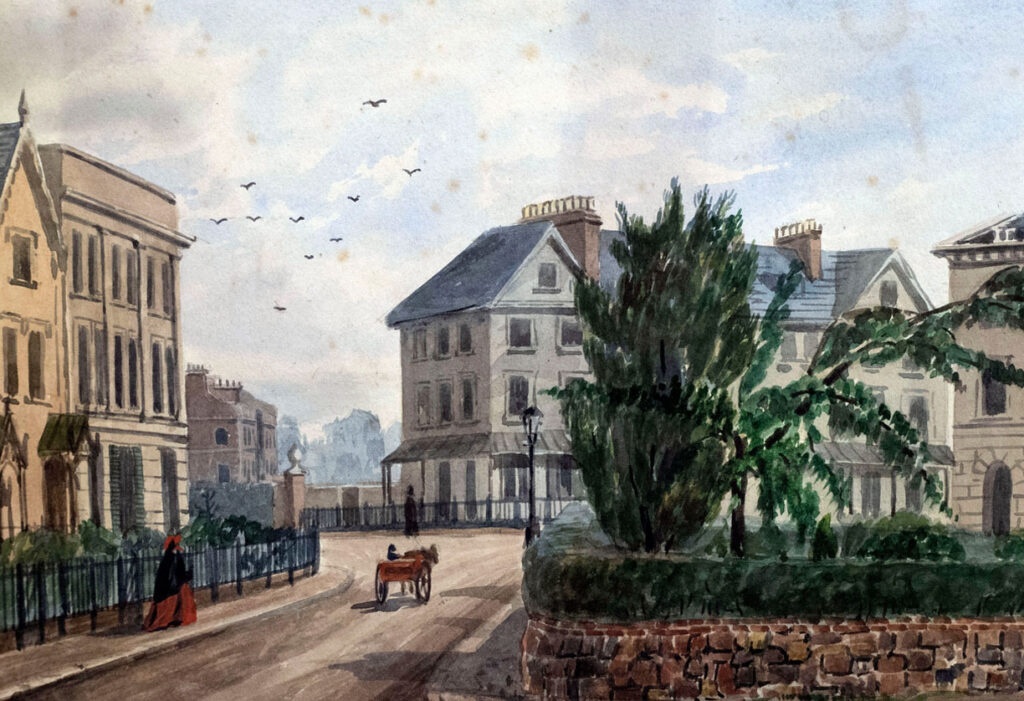Researched by Heritage Advisory Group
Queens Terrace, Bystock Terrace and Richmond Road form an enclosure to a car park. Trees make a positive contribution to the character of the area and the shape and size of the space is attractive, but the car parking with poor surfacing and inadequate landscape treatment is a negative element.
Number 1 Bystock Terrace is a prominent listed building with a succession of alterations that in total detract from the original building form. Numbers 1-8 Bystock Terrace have Tudor Gothic details and are in use as hotels.The Bystock Terrace houses show an assertive Tudor Gothic architectural style which the Victorians liked to describe as ‘Old English’. Like other early-Victorian houses they have stucco frontages pierced by regular grids of windows, but their façades are crowned by a rich medievalising roofline with high, pointed gables towards the street.
The entrance doorways have oval arched heads and doors decorated with fillets rather than conventional panels.The windows are all framed by Tudor style drip mouldings, and feature timber ‘mullion and cross’ casement windows rather than the usual sashes. Above the roofs the chimneys of the Bystock Terrace houses originally divided into clusters of tall shafts and the bay windows to the ground-floor rooms are given a military character by miniature battlements, Unfortunately, like the chimney stacks, many of the bays have been inappropriately altered and the Gothic detail removed.
The terrace of three to four storey Gothic houses was built in about 1845 and within a few years half of the ten properties were used as boarding houses.
In 1848 one of the occupiers, who signed a letter to a newspaper editor as `Stick in the Mud’, also described herself as one of the unfortunates unlucky enough to have rented a house in the terrace, complained to the city council that the amount of mud on the road leading from Church Road to Pound Lane (later Elm Grove Road) was so considerable that a cob-house could be made with it.
That same year `a gentlemanly looking man’ who called himself Mr Butcher, took lodgings in the terrace while he took a shop in Queen Street to sell tea. He employed two to three drapers, ironmongers, cabinet makers, upholsterers, haberdashers, tailors, silversmiths, furriers and dressmakers in fitting out the business but absconded leaving his shop fittings but having taken his personal valuables and moveables which included a gold watch estimated as being worth one hundred pounds.
He was described as `six feet high, erect, roundish face, rather full dark whiskers, teeth a little imperfect’ while his wife, a `well-dressed little woman’, was `rather below middle stature, apparently about 28 years old, enceinte in appearance, generally wearing a white veil, her face rather of rosy hue and very probably now she figures with a gold watch’.
In 1893 Number Nine was occupied by an inspector for the National Society for the Prevention of Cruelty to Children and used as a place of safety for rescued children. They had previously been sent to the city’s workhouse in Heavitree Road. The following year Rose Anna Beamer of Bampton, sixteen months old, died in the shelter. Her parents had fourteen children of whom eleven had died and were charged with cruelty to their daughter. The NSPCC continued their work safeguarding children at Bystock Terrace for a number of years.
